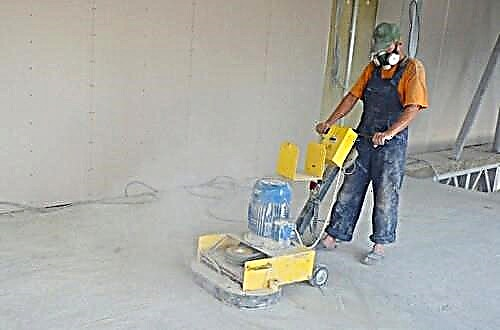
Sometimes, after pouring a concrete mortar and rammer, a gray crust is collected on the surface, from a distance similar to water. This is cement milk. Regardless of the brand of cement used, it will always form, but in small quantities it is not scary.
If the crust appeared in large volumes - this means that the ratio of water to cement was violated during mixing. In this case, the film will suffer poor service, because after drying it forms a thick crust on the concrete surface. It will prevent concrete from adhering to subsequent coatings, such as varnish, paint or liquid waterproofing. Ultimately, the topcoat will last a maximum of a year, will slowly crumble and move away.
Methods for removing film from a concrete surface
- The mechanical way. Here, sandblasting or crushing machines are most often used. A plus is the ability to remove allocated milk from hard to reach places. The downside is the high cost of equipment and the difficulty in operation.
- Manually. It is proposed to use metal brushes. This is not expensive at all, but it will require a lot of effort and time, because each area will have to be brushed manually.
 Dry cleaning. The only plus is a record-breaking short time in which you can quickly get rid of cement milk. For dry cleaning, special solutions containing acid, for example, hydrochloric or acetic, are used. They affect not only the unwanted film released after the concrete was laid, but also the cement “body” itself. This method of cleaning should be chosen in the case when other methods did not give the desired effect. To neutralize the plaque removal solution, concentrated alkali can be used. After completing the procedures, the treated surface is thoroughly washed.
Dry cleaning. The only plus is a record-breaking short time in which you can quickly get rid of cement milk. For dry cleaning, special solutions containing acid, for example, hydrochloric or acetic, are used. They affect not only the unwanted film released after the concrete was laid, but also the cement “body” itself. This method of cleaning should be chosen in the case when other methods did not give the desired effect. To neutralize the plaque removal solution, concentrated alkali can be used. After completing the procedures, the treated surface is thoroughly washed.
Use in construction work
Milk also has positive properties and is often specially prepared. Such a solution is characterized by a simple structure, fluid consistency, consists only of cement and water, and, as a rule, does not include additional components.
Cement milk is used to create floors, roofing and attic floors, the insulation of which is carried out using expanded clay. Expanded clay is, in fact, a lot of granules, different in weight and composition among themselves. And if large ones immediately settle down, then small parts, mixed with liquid, rise up. Strength is greatly reduced.
After the expanded clay has been laid and leveled, a layer of cement milk should be laid on its surface. A sufficient depth of the interlayer is 2 cm. The solution will protect and also serve as the basis for subsequent topcoats. In addition, the milk will reliably adhere small particles of expanded clay, penetrating deep into the backfill.
There is no exact, regulated composition. To achieve the structural form, usually take one part of cement and two parts of water. The viscosity of cement milk resembles a kefir-like consistency, which can be changed by adding water or cement. The composition will be perfectly absorbed into the expanded clay, capturing all the granules and covering them with a film of astringent. After everything is dry, expanded clay backfill will become solid and durable.
Advantages
When the milk itself appears on the surface of the poured concrete, it causes some trouble. However, when a solution is prepared for certain jobs, it has a number of positive aspects.
Pros:
- reliability,
- the ability to retain heat inside the house,
- the ability to not let in sounds from outside,
- leakage resistance,
- quick hardening
- simplicity and ease of laying.
The deformation of the upper concrete and reinforced concrete layers can also be prevented by the use of this solution. Simply spill them carefully with the solution before use.
Where to apply
 Cement milk has a wide range of applications. For example:
Cement milk has a wide range of applications. For example:
- to eliminate cracks and chips in the base of the concrete mass,
- to impart heat-insulating properties to the coating (it is necessary to shed a claydite layer with a solution),
- to strengthen the underlying layers when forming the foundation,
- repair and repair of damage that appeared in old concrete,
- for processing metal containers, because the solution enhances the anti-corrosion properties,
- for leveling the surface.
In addition, cement milk can be used for other purposes:
- as a fixation of powders under the coating of bars,
- help reduce surface porosity by making the coating smoother,
- as a process fluid when working with concrete pumps.
Milk consumption per 1 square meter of area depends on the purpose for which it is used. The cost of one cubic meter will depend on the proportions of the components that make up its composition.
Mixture preparation
The technology for the preparation of cement mortar is quite simple. First, calculate how much work is supposed to be done. Based on this, calculate and measure the right amount of cement. It is important to remember that there should be 2-3 times more water than cement. Such a solution is not regulated by any standards, so you need to measure it “strictly by eye”, depending on the specific task.
Further, everything is quite simple:
- add a small amount of water to the measured amount of cement and mix to a uniform consistency.,
- without stopping interfering, gradually add water to make the milk more fluid and uniform,
- in the event that there is not enough cement to prepare the required amount of the mixture, slaked lime can save the situation. It can act as a substitute for a small part of cement powder.
Sometimes, for the preparation of cement milk, a primer is also used as an additional component. After stirring, the mixture with the addition of a primer can be passed through a sieve to get rid of possible lumps and debris. This will help to achieve a more uniform mixture.
Most often, the following types of cooking recipes are used, depending on the work that needs to be done:
- if the task is to patch the cracks with a solution, you need to mix cement powder with water in a ratio of 1: 2,
- to strengthen the screed, cement should not be present in the solution by more than one third,
- to make a forgiving layer under the foundation, it is necessary to mix cement with water also in equal quantities,
- if the task is to fill in a layer of milk after filling expanded clay, the mixture should be more fluid. It is necessary to observe the proportions - 1 part of cement to 3 parts of water,
- for wall decoration, a more fluid mass is also used, which can be obtained by mixing cement powder with water in 1: 3 proportions. In this case, there is no difference, the internal or external wall decoration is performed.
To obtain a more uniform consistency of the finished solution, it is advisable to use a drill with a special nozzle in the form of a whisk. She will get rid of lumps after mixing. And adding slaked lime to the cement mixture, you can achieve greater ductility. The consistency in this case will resemble liquid glass.
For spills of expanded clay, you need to prepare a solution of optimal density. To check whether the obtained cement milk meets the specified requirements, carry out the following algorithm of actions:
- on a surface covered with expanded clay, select a small area, fill it with the mixture obtained,
- wait 20 minutes for the liquid to dry and impregnate expanded clay,
- after the allotted time, check the result,
- in the case when the solution escaped into expanded clay and nothing remained on the surface, the milk turned out to be liquid. Add more cement to it,
- if most of the solution remained on the surface - the milk turned out to be too thick, dilute it a little with water,
- A good option would be one when most of the solution seeps into expanded clay, but a thin layer of cement spillage remains on the surface. Thus, expanded clay particles will be reliably adhered, and its surface will be smoother and more even, due to the frozen thin layer of the solution.
What it is
If the composition of the mortar for arranging the cement screed includes three components: cement, sand and water, then sand is not needed to prepare the cement milk. Moreover, the proportions of materials in this case are not regulated by GOST, SNiPs or other regulatory documents. However, experience shows that to obtain milk of normal consistency, with the same consumption of binder, you need to take three times more water than when preparing a solution for screed.
It is very simple to check the density of cement pouring:
- First, we spill a small area of expanded clay pillow,
- we observe 15-20 minutes,
- option 1 - the milk has completely leaked through the pillow and there is no film left on the surface of the expanded clay grains, which means the milk turned out to be too liquid and you need to add cement,
- option 2 - almost the entire mixture, or most of it, was delayed on the surface of the insulation, such a composition requires more water.
Thus, the most optimal ratio of water to cement is selected in each specific situation. And the consumption of cement milk per 1 m 2 of the cultivated area is taken in such an amount that the expanded clay layer is well saturated with it, but not flooded.
Cement milk preparation
The technology for preparing a solution for pouring expanded clay base is extremely simple. Based on a given amount of work, it is necessary to measure the estimated amount of cement. To make a solution per 1 m 3, the consumption of binder M 300 will be 260-300 kg. Keep in mind that water will need two to three times more than cement. Further:
- we shut the cement with a small amount of water and stir until a homogeneous creamy mass is obtained,
- with constant stirring, gradually add water, making the solution fluid,
- a certain amount of cement can be replaced with slaked lime, which will significantly improve the plasticity and moisture resistance of the composition.
As an additional component, a primer is added to the cement milk. It is recommended to pass the cement through a fine sieve before starting use to prevent the formation of lumps.
The process of stabilization of expanded clay interlayer
Pouring expanded clay with cement milk is designed to perform the following tasks:
- increases the structural impermeability of the bulk formation, strengthening it,
- allows you to get a reliable filling of the free sinuses between the individual granules of expanded clay,
- expanded clay spilled with cement milk acquires additional strength and density.
After the cement hardens, the expanded clay layer becomes more stable; movement of workers and light mechanisms is permissible on it without destroying the integrity of the upper layer. It is easier and more confident to perform work on the screed device, without fear of “floating up” of the insulation granules.
Cement milk should be prepared in such portions that they are consumed without residue, since after prolonged storage of the composition, cement can settle. With repeated mixing, it will be difficult to achieve a uniform consistency.
Expanded clay should be shed gradually, waiting for the complete impregnation of the entire mass of insulation. Proceed with subsequent work after the cement milk has completely dried, after about 24 hours. When working with expanded clay, it should be taken into account that it is practically impossible to create a slope with this material due to its flowability. In this case, not dry expanded clay is used, but a mixture consisting of expanded clay gravel, sand, cement, water and the necessary additives. In other words, such a preparation is made of light heat-insulating concrete mix.
Cement milk is used not only for impregnating expanded clay, but also for the ironing of concrete surfaces, for grouting cracks, in order to strengthen the bedding under paving stones, as a technological material during the operation of a concrete pump and in other cases.
Cement milk - what is it?
Typically, inexpensive Portland cement and water are used to knead the composition. Proportions are determined depending on the type of application. The simplicity of cooking allows you to make it yourself. On a large-scale construction scale, the construction of reinforced concrete structures by vibrating also releases a water-cement mixture. This is a signal to stop the vibration, otherwise the solution may delaminate. Being a waste product, cement milk is a water-insoluble coating of calcium carbonate salt. It is formed due to the chemical reaction of calcium hydroxide, which is released on the surface of a stone with carbon dioxide in the air.
The formation of a large amount of liquid indicates a violation of the ratio of water to cement in concrete.
Why remove cement milk?
In the case of concrete filling works, finishing stages are assumed in the future. More often it is the application of a different coating, for example, coloring. A whitish solution creates an intermediate layer between the solid surface and the paint, preventing it from soaking deep into the stone. In addition, the structural strength is reduced due to the separation of the monolith. Over time, the water-cement mixture will begin to peel off independently along with a layer of paint. This is a poor-quality work, which does not guarantee the durability of the coating. Therefore, the milk film must be removed, and until the mass solidifies. If the concrete is still dry, it begins to shine like gloss.
Withdrawal methods
The application of any method should be justified specifically in each situation. The table shows the main methods for removing milk:
| Method of exposure | Applicable Tools | Features |
| Mechanical | Metal brushes, broom, scraper | Not suitable for large areas |
| Crushing and sandblasting machines | Costly and time consuming method | |
| Water or air stream (special equipment) | Not suitable for cured film (water insoluble) | |
| Chemical | Solutions based on hydrochloric or acetic acid | It is carried out strictly according to the instructions |
 After using the chemical method, a mandatory step is to treat the surface and wash thoroughly with water.
After using the chemical method, a mandatory step is to treat the surface and wash thoroughly with water.The latter method is rarely used, since chemical reagents not only remove the white suspension, but also negatively affect the properties of the artificial stone. After applying the acid, treatment with concentrated alkaline solution is recommended until complete neutralization. Safety is important. After thoroughly rinse the surface with water.
Building Material Properties
The characteristics of this simple mixture largely depend on the given proportions. By consistency, you can get a suspension, suspension or batter. Strength is affected by the brand of cement. When lime is added to the solution, an interesting texture and white surface color are obtained. The homogeneity of the material is also important, otherwise during application the uniformity of the layer and its strength will not be achieved. The main properties include:
- water resistance and smoothness of the hardened composition,
- good sound and heat insulation,
- the ability to fill small cracks,
- quick hardening
- reliability,
- corrosion protection,
- ease of use.
Application
Cement milk actively entered into all stages of a different scale of construction. The situations when it is necessary to use a water-cement mixture include:
 Cement milk has found its application in work such as smoothing the coating or pouring small cracks or chips.
Cement milk has found its application in work such as smoothing the coating or pouring small cracks or chips.
- Alignment of surfaces.
- Filling of small cracks and chips.
- Thermal insulation of expanded clay layer.
- Reinforcement of the bottom base cushion.
- "Repair" of an old artificial stone.
- Protection of metal containers to give anti-corrosion properties.
- Strengthening the bedding under the bars.
- Reduced porosity of surfaces.
- Preparing walls for tiles or tiles.
- Flushing concrete pump hoses.
Concrete fermentation is the isolation of a stone surface from aggressive external influences by treatment with concrete milk.
Features backlog
Before preparation, dry powder must be sieved thoroughly to avoid clumping and debris of the solution. For mixing, it is better to use a construction mixer. Water must be added gradually and slowly, constantly stirring the mass. If cement is not enough, slaked lime can be added. Occasionally, an additional component is a primer. The table shows the proportions of the ingredients depending on the scope:
Composition
The recipe is not regulated. The concentration of components is determined individually, according to the characteristics of production, scope. The viscosity of a cement-water solution corresponds to a kefir-like consistency, varies in proportion to the concentration of ingredients (cement, water):
- With equal proportions of components, the viscosity corresponds to the suspension.
- When doubling the concentration of water, the mass is a mixture of cement particles.
- An increase of 1.5-2 times the proportion of cement leads to an increase in viscosity, corresponding to the liquid test.
Due to the lack of a clear proportion of the mixture, developers use it with different concentrations of ingredients. The ratios of the parts can be equal, however, developers widely use mixtures with a water concentration 3-4 times higher than the proportion of astringent. It all depends on the level of tasks.
How to get the mixture?
Cement milk, although it has a primitive composition, is used by developers as a special subspecies of the solution, without aggregate. The mixture is prepared as follows:
- by special dilution of Portland cement with water without the use of fillers and sand mass. The proportions of the components are selected taking into account specific tasks, are not regulated by building codes,
- in the process of forming reinforced concrete structures, their vibrational compaction. In the manufacture of reinforced concrete products, a small volume of liquid concrete fraction, called milk, is collected on the surface of the products. The appearance of the liquid phase indicates the need to stop the vibrational compaction of the concrete mass. The liquid fraction is removed from the concrete surface of the products, used to perform various operations.
Areas of use
Depending on the composition used, cement milk is used to perform the following tasks:
- Sealing microscopic cracks on the surface of a concrete mass. To prevent cracking, milk is prepared, the concentration of water in which is twice the proportion of cement. The mixture is prepared by thoroughly mixing the cement with water using a drill with a nozzle. The surface of the concrete mass is strengthened by spilling it with milk.

The proportions for the manufacture of cement milk are selected depending on the purpose of the operation

 Dry cleaning. The only plus is a record-breaking short time in which you can quickly get rid of cement milk. For dry cleaning, special solutions containing acid, for example, hydrochloric or acetic, are used. They affect not only the unwanted film released after the concrete was laid, but also the cement “body” itself. This method of cleaning should be chosen in the case when other methods did not give the desired effect. To neutralize the plaque removal solution, concentrated alkali can be used. After completing the procedures, the treated surface is thoroughly washed.
Dry cleaning. The only plus is a record-breaking short time in which you can quickly get rid of cement milk. For dry cleaning, special solutions containing acid, for example, hydrochloric or acetic, are used. They affect not only the unwanted film released after the concrete was laid, but also the cement “body” itself. This method of cleaning should be chosen in the case when other methods did not give the desired effect. To neutralize the plaque removal solution, concentrated alkali can be used. After completing the procedures, the treated surface is thoroughly washed.

